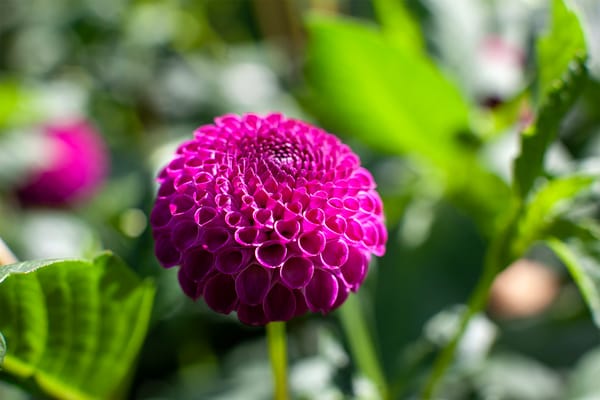In Cornwall and the greater Southwest, few flowers capture the heart quite like the dahlia—an emblem of late summer’s boldness, resilience, and unabashed beauty. Yet, growing these flamboyant blooms in our region’s unique climate brings its own set of trials. Damp springs, humid summers, and the ever-present Cornish mizzle create the perfect backdrop for a spectrum of pests and diseases. To grow dahlias with confidence, a nuanced, season-savvy approach is essential. Integrated Pest Management (IPM) isn’t just a method—it’s a gardener’s rhythm with the land, blending observation, prevention, and natural balance.
1. The Key Threats: Viruses and Pests to Know
Viruses: The Invisible Enemy
Dahlia viruses, particularly the ubiquitous Dahlia Mosaic Virus (DMV), are silent thieves of vigour. They distort leaves, stunt growth, and suppress flowering—often without clear early signs. More worrying are emerging threats like Tomato Spotted Wilt Virus (TSWV) and Impatiens Necrotic Spot Virus (INSV), both transmitted by thrips.
- DMV — Mosaic patterns, yellowing, distorted leaves
- TSWV/INSV — Ringspots, bronzing, necrotic lesions, stunting
Infected plants remain carriers for life. There is no cure, making clean stock and vigilant observation the gardener’s strongest allies.
Thrips: The Subtle Saboteurs
Small but destructive, thrips feed by rasping plant tissue, leaving silvery marks and deformed flowers in their wake. They are notorious virus vectors, particularly in warm, dry spells—a common occurrence in late Cornish summers.
Capsid Bugs: The Early Summer Scourge
These sap-feeders puncture young shoots, causing pale, puckered leaves or bud drop. Their damage peaks in early to mid-summer, often mistaken for nutrient deficiency or disease.
Cornish-Specific Challenges
- Slugs & Snails — Thrive in damp conditions, attacking stems and tubers.
- Earwigs — Night feeders, infamous for shredded petals and leaves.
- Aphids — Abundant in mild climates, they weaken plants and spread viruses.
- Spider Mites — Emerge during hot, dry periods, causing bronzing and stippling.
2. IPM Through the Seasons: A Gardener’s Calendar
| Season | Key Risks | Recommended Actions |
|---|
| Spring | Virus introduction, slugs | Plant virus-free stock; apply slug barriers; inspect tubers; clear debris |
| Early Summer | Aphids, thrips, capsid bugs | Weekly checks; install sticky traps; companion planting; begin biocontrol releases |
| Summer | Thrips, earwigs, slugs | Set straw traps for earwigs; reinforce slug barriers; prune pest damage; apply neem/soap spot-treatments |
| Late Summer | Virus spread, spider mites | Remove infected plants; encourage predators; maintain garden hygiene |
| Autumn | Slugs, rot, virus carryover | Harvest healthy tubers; sanitize tools; remove debris; mulch appropriately |
3. Expert Advice for Targeted Threat Management
Virus Management: Prevention Above All
- Source tubers from certified, virus-free suppliers.
- Regularly inspect for mottling, stunted growth, or distorted leaves.
- Remove and destroy any symptomatic plants—do not compost.
- Sterilize tools with disinfectant between plants.
- Manage aphid and thrip populations diligently.
Thrips and Capsid Bugs: Twin Terrors of Summer
| Strategy | Thrips | Capsid Bugs |
| Biocontrol | Release predatory mites (Amblyseius spp.), Orius bugs | Encourage ground beetles, spiders |
| Physical Control | Sticky traps, fine netting | Remove weedy margins, prune damage |
| Targeted Spray | Neem oil, insecticidal soap (avoid flowers) | Spot-treat only, use as last resort |
Weekly monitoring—especially of new growth and undersides of leaves—can’t be overstated. Rogue out affected parts promptly to halt spread.
Cornish Pests: Time-Tested Defences
- Slugs & Snails — Use sheep’s wool pellets, copper tape, hand-pick at dusk. Avoid overly moist mulches.
- Earwigs — Deploy straw or newspaper traps; remove at dawn. Keep borders tidy.
- Aphids — Encourage ladybirds, lacewings with dill, fennel, and yarrow. Use water sprays or neem oil for infestations.
4. Summary Table of Threats and IPM Solutions
| Pest/Threat | Peak Season | Symptoms/Damage | IPM Measures |
| Viruses | All season | Yellowing, stunting, ringspots | Virus-free stock, rogue infected plants, tool hygiene |
| Thrips | Early–late summer | Silvery streaks, distorted growth | Biocontrols, sticky traps, neem/soap |
| Capsid Bugs | Early–mid summer | Pale, puckered leaves | Weed control, prune damage, encourage predators |
| Slugs/Snails | Spring–autumn | Chewed stems, leaves | Wool pellets, copper, evening hand-pick |
| Earwigs | Summer–autumn | Chewed petals, leaf tips | Straw traps, clean garden hygiene |
| Aphids | Spring–summer | Clusters on new growth | Ladybirds, water jets, soap sprays |
| Spider Mites | Hot, dry spells | Leaf stippling, bronzing | Humidity control, predatory mites, neem oil |
5. Pro Grower’s Tips for a Healthier Dahlia Season
- Begin Before You Plant: Prevention always trumps cure. Start IPM measures when tubers break dormancy.
- Plant for Balance: Companion planting with beneficial-attracting herbs isn’t just pretty—it’s strategic.
- Observe, Record, Respond: Make inspections a weekly habit. Garden health is won by noticing before damage escalates.
- Minimize Chemical Use: When needed, choose pollinator-safe, targeted treatments and apply in the cool of evening.
- End-of-Season Clean Up: Remove debris, clean tools, and store only healthy tubers—next year’s success begins in autumn.
With patience, observation, and thoughtful interventions, dahlia growers in Cornwall and across the Southwest can outpace the pressures of pests and disease. By weaving traditional wisdom with modern IPM strategies, you’ll not only safeguard your collection but create a thriving, resilient garden that flourishes with every season.











